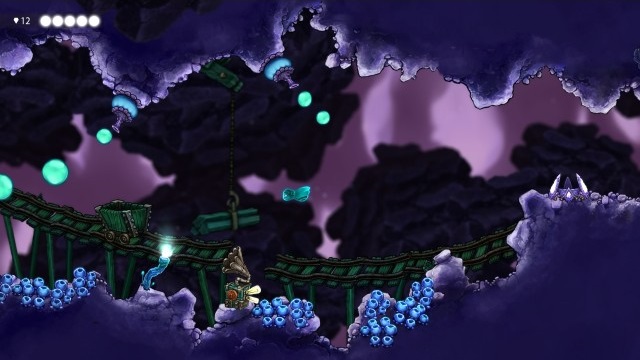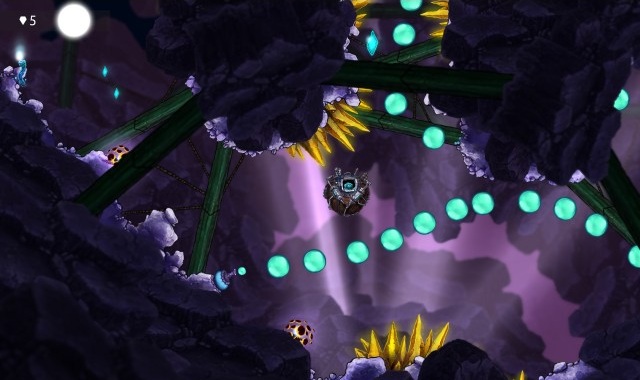Phat Beats.
Beatbuddy: Tale of the Guardians has a novel approach to its action-adventure gameplay. The game is set in a world of Symphonia, where the music created by three guardian deities, Harmony, Melody, and Beatbuddy, sustains the underwater world. When the arrogant Prince Maestro tries to take control of that power by capturing Harmony and Melody, unbalancing the world order, Clef, a bearded mechanic of sorts, wakes up Beatbuddy to come to the rescue.
The game's musical bent isn't just paid lip service. Enemies and obstacles pulse and shoot to create beats and notes that add to the song as you encounter them. By paying attention to the patterns in the music, some enemy fire can be avoided and some enemies can only be defeated by being struck in time to the beat.
Beatbuddy is a side-scrolling action/adventure/platformer "thing." You can't really call it a platformer in the truest sense of the word, since you swim from location to location—and there aren't platforms—but it follows the basic mechanics solidly with various enemy types and objectives. Most of the gameplay sections are centered around puzzles that involve carrying bubble-catching devices or energy spheres from one location to another, avoiding enemy obstacles and flipping switches to open gates. The game's most challenging moments are when these puzzles have a timed element that require dashing, while carrying one of these keys, through areas of shooting or pulsing enemies while time winds down before it explodes.
Beatbuddy's weakest sections are the luckily infrequent vehicular areas where you pilot Clef's clunky, spherical submersible around and through giant jellyfish. These sections are eventually augmented with a gun that gets attached to the machine, but the timing of the enemy or environmental hazards doesn't always sync with when you can dash with the ship, which can create some frustration. Also, the submersible can sometimes be too maneuverable, particularly if you are caught in a line of jellies, causing you to crash into the enemy over and over. This has been addressed somewhat with regenerating health while in the ship, but it feels like a bit of a cheap fix for what's a problem with the overall sync of the vehicle's movement to the level design.
However, in the regular gameplay sections the puzzles are very well-constructed, which is a tribute to the hard work put in by developer Threaks, who started it as a school prototype and have built it over the last four years into a nice, little game. It does a great job of introducing new enemies, features, and skills that Beatbuddy can use to handle these challenges, slowly building more complex puzzles and challenges throughout its five-plus hours of gameplay. Music buffs will appreciate that it features music by Parov Stelar, Sabrepulse, La Rochelle Band, and Grammy-nominated game composer Austin Wintory.

A lot of whether Beatbuddy works as intended depends on whether you like jazz-infused electronic music. It isn't required to play the game, since the enemy patterns can be learned with the sound off, but it's definitely a facet of the gameplay that each enemy moves to the track of the song. As much as this is a cool device, it unfortunately means that sometimes the songs can be a bit overly repetitive in some areas (especially if you haven't quite figured out a puzzle just yet) or the music can cut out almost completely when you move from one puzzle or combat section to the next without their influence.
Or alternatively, if a song element that has been created by an enemy adds nicely to a song, it can sometimes be your job to cut it out as you move past it, like the hi-hat crabs or the kick-drum jellies that have glommed onto switches or mirrors. Stopping or removing elements that make the song sound more complete sometimes feels like it's against the game's basic design. It might have been a nicer idea for those elements to drop in instead of out as challenges arecompleted. Beatbuddy is still a lot of fun, though, and while the game is intended entirely to be played as a musical experience, it has strong enough visual pulses in its beautiful, hand-drawn 2D look to be able to learn and keep to the patterns even when silenced.
I played Beatbuddy using a mouse, though it appears optimized for gamepad controls. Originally I tried to use keyboard controls, but found that I couldn't get them to work on the Mac build I was playing. But even with the mouse, after it took me a little while to adjust, play control was clean and easy.

The game has some nice replay value, with collectible gems unlocking the story of how the game was made, in postcards that can be accessed from the main menu. It's really cool to be able to read more of the developers' story on how the game came together, featuring art and design elements the more you accomplish in the game itself.
Beatbuddy feels well worth the $15 sticker price on Steam for Mac, PC, and Linux. While sometimes it feels like its musical ambitions are inhibited by the game design, it's still a strong game in its own right and it's fun to see how the musical elements and enemies combine together as gameplay features.
-
Strong level design and puzzles
-
Novel music gameplay elements
-
Music sometimes inhibited by gameplay
-
Beautiful 2D hand-drawn graphics
-
Vehicles sections aren't as strong
-
Electronic music built into design







